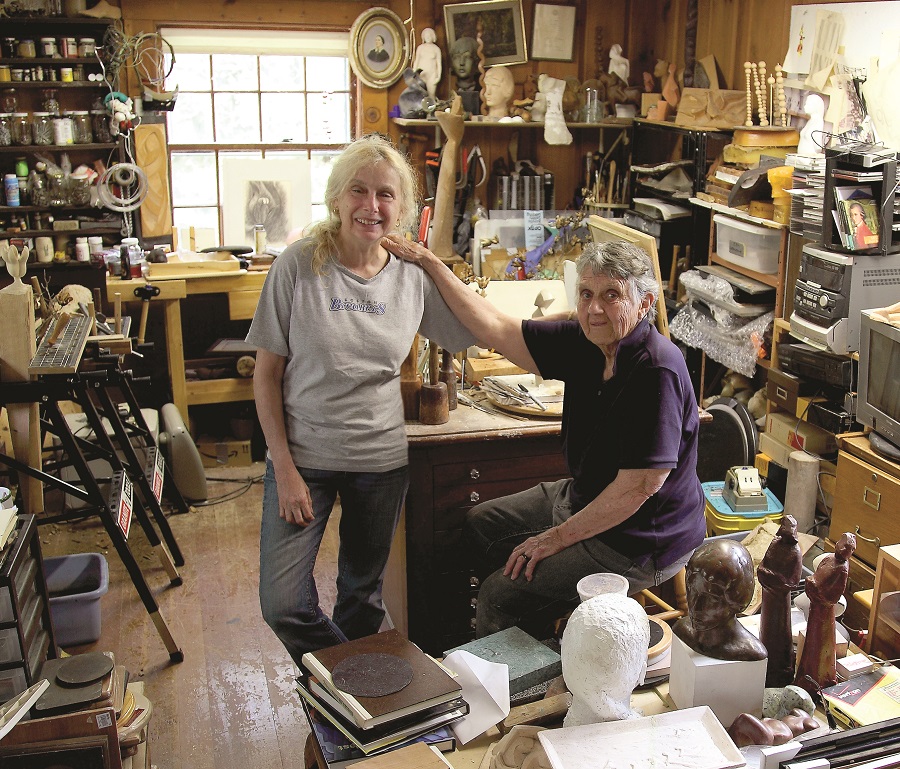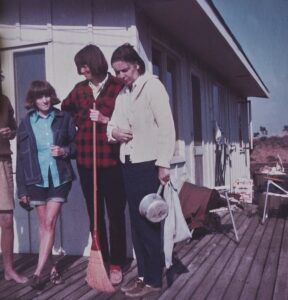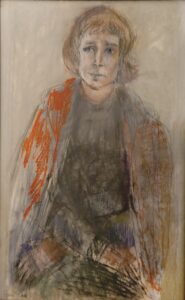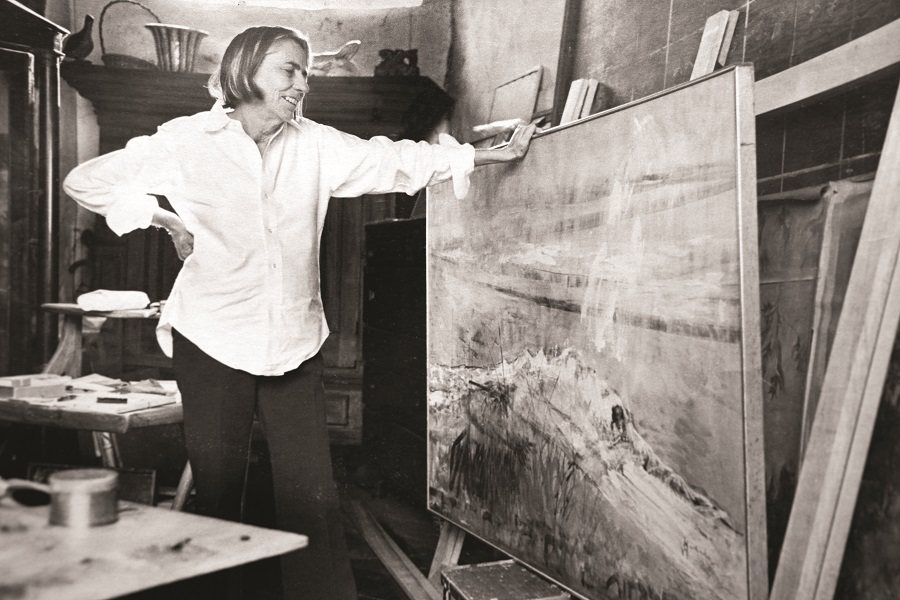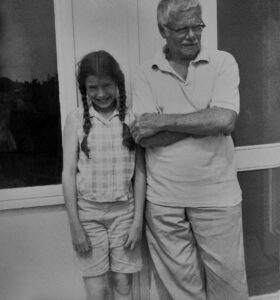Anna Poor’s Truro studio, nestled amid scrub pines and tall grass, has an atmosphere of simplicity and unvarnished beauty. Inside, the studio is almost fully occupied by a large table on which the artist has spread a collection of ceramic sculptures made over the past year. She’s preparing for an exhibition at Schoolhouse Gallery in Provincetown. A few pieces are still in the kiln at nearby Castle Hill, but for the most part, her work is complete.
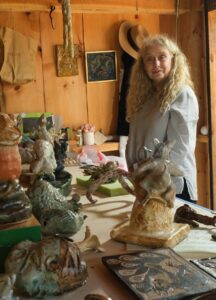
Behind the table, a ceramic rat’s tail is nailed to the wall, flanked by two wings. Droopy ceramic letters hang above the table, spelling out the word “ouch.” At the front of the table are a pair of wonky, oversize pink glasses created from lumpy lengths of clay. They look like intestines.
“This is my world,” Poor says, holding the glasses to her head. “You’re looking at my chaos.”
Her animals are of indeterminable type. Most look like variations of long-nosed rats, but sometimes they have elongated bird-like necks, wings, or fox ears.
“They’re all self-portraits,” says Poor. “I’ve probably become a rodent.”
She points to one of the pieces she made in the fall. It looks like a mouse. Then she picks up a recent one with fox ears. “I have evolved to a fox,” Poor says. “The ears have become pointed. It’s still me. I guess I’ve gotten smarter. Or maybe a little more dangerous.”
The animals are undeniably cute and full of personality. In Landscape of No, a melancholic, blob-like sea creature leans off a curved form arising from the sculpture’s base as it spells out the word “no.”
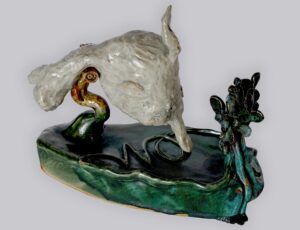
The intimate scale of Poor’s sculptures is matched by a miniaturist concern for detail. She etches lines into the clay to create facial expressions, usually pained or bewildered, and constructs the animals’ bodies to convey equally expressive gestures. Miniature ears lie recumbent in some pieces. In others, they’re perky. In one of the sculptures, a creature’s little arms cross its chest as if in self-defense.
“I want to pull you in by their beauty and sweetness,” says Poor. But there’s a sideways narrative that tempers that cuteness. The creatures are “all in states of distress or confusion,” she says. In Joan of Arc’s Baby Bat, a bat sits among a pile of sticks, including one piercing its side. “Ouch” is written in cartoon-like letters at the base of the piece. A rust-orange flame (or is it a flower?) rises behind the bat’s back.
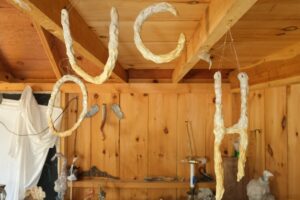
There’s vulnerability in the form and material of this work. Poor says that at openings she’s always nervous that someone will knock something over. She often works in bronze, and she loves the material’s clarity of line and its strength. But ceramics are fragile and “more things are left to chance,” she says. The firing process alters the color of glazes and can unexpectedly change the way lines and marks appear on the surface.
Her forms also have a feeling of being in flux. They are not refined into clean, sharp shapes; rather, she perfects her forms through accumulated touch.
Many of the sculptures feature arches or holes. In one piece, two ducks, one wearing a clock around its neck, balance precariously on a thin arch. Another sculpture depicts two birds sitting atop a brain-like shape where letters from the word “ouch” compromise the stability of the form. The “o” creates a hole in the brain. Negative spaces become wounds.
A viewer is left wondering what happened in this world. “No,” “sorry,” and “ouch,” are recurring words in these sculptures. There are also a lot of clocks. In After Rodin, a piece influenced by Auguste Rodin’s sculpture of the French novelist Honoré de Balzac, a clock hangs by a chain around the neck of an entrapped rat. Time seems to be a culprit in this sculpture.
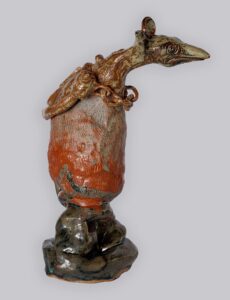
Other pieces, like Joan of Arc’s Baby Bat, deal with self-sacrifice, a theme in some of Poor’s earlier work. “I’m interested in the whole idea of sacrificial lambs,” she says, and the notion of “people being brave and giving up something for someone else.”
Trust, a sculpture of a fox with its arms around a bird stuck in a ball, could be a gesture of protection, but it’s more ambiguous than some of the other sculptures. “Is he protecting this bird ball or taking it off to eat?” asks Poor. She’s inclined to give him the benefit of the doubt.
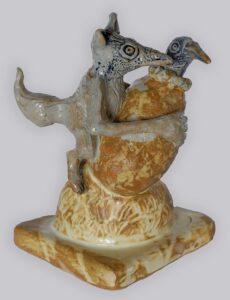
She loves these creatures. “Nobody’s vicious,” says Poor. “Look at those little faces. They’re all in real misery and confusion. I can say for a fact everybody here is just doing the best that they can.”
Though they’re autobiographical, the sculptures aren’t melodramatic or overly intimate. She points out the recurring words and themes of sacrifice and trust, and then adds, “We won’t get into why.” This is a world of metaphor where the animals both reveal and disguise the artist’s personal drama.
One crisis that Poor does discuss is a recent creative block. Before starting this group of sculptures last year, she didn’t make art for about two years. This was a big break for Poor. Inside her Truro house — which her grandfather, artist Henry Varnum Poor, built out of plywood and other simple materials — hangs a drawing he did of Anna as a child. In the picture, she’s seated on the floor, drawing. Henry would often draw with his granddaughter, etching lines into the sand with a stick at Ballston Beach before the waves came up to claim the images. Since those early years, Anna has continued drawing and making things.
She studied art at the Mass. College of Art and Design and UMass Amherst. Her art practice developed a steady rhythm. During the fall in Boston, where she also lives, she “doodled constantly.” Those drawings served as the basis for sculptures that she would start in Boston and then bring to Truro, where she usually finished them and exhibited the work.
When Poor stopped making art a few years ago, she had a crisis of faith about its value. “I felt there were too many objects in the world,” she says. “I didn’t want to add or make something mediocre.” Her hands itched to make things, but she couldn’t. “That was a bad place,” she says.
Eventually, the fog lifted. This is the first group of sculptures she has made since that creative block, but the pain of that period is clear in these sculptures, along with the pain many are experiencing at this moment in the world.
“We’re living in this time where we’re all in a state of pain and disbelief, right?” says Poor. “It’s like holy shit, oh my God.”
OUCH
The event: An exhibition of sculptures by Anna Poor
The time: Aug. 22 to Sept. 14; opening reception Friday, Aug. 22, 6-9 p.m.
The place: The Schoolhouse Gallery, 494 Commercial St., Provincetown
The cost: Free
